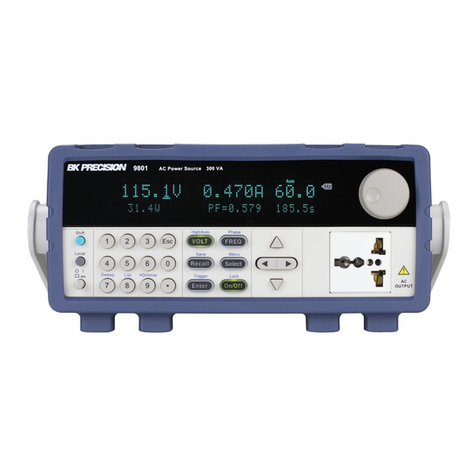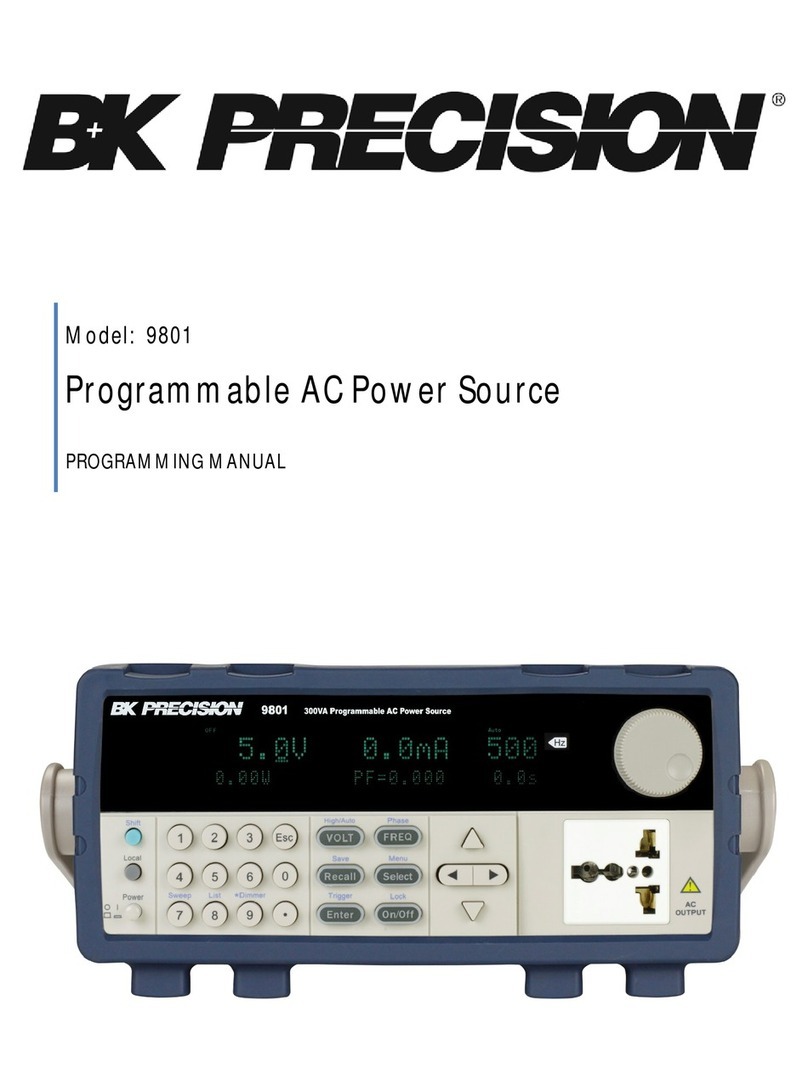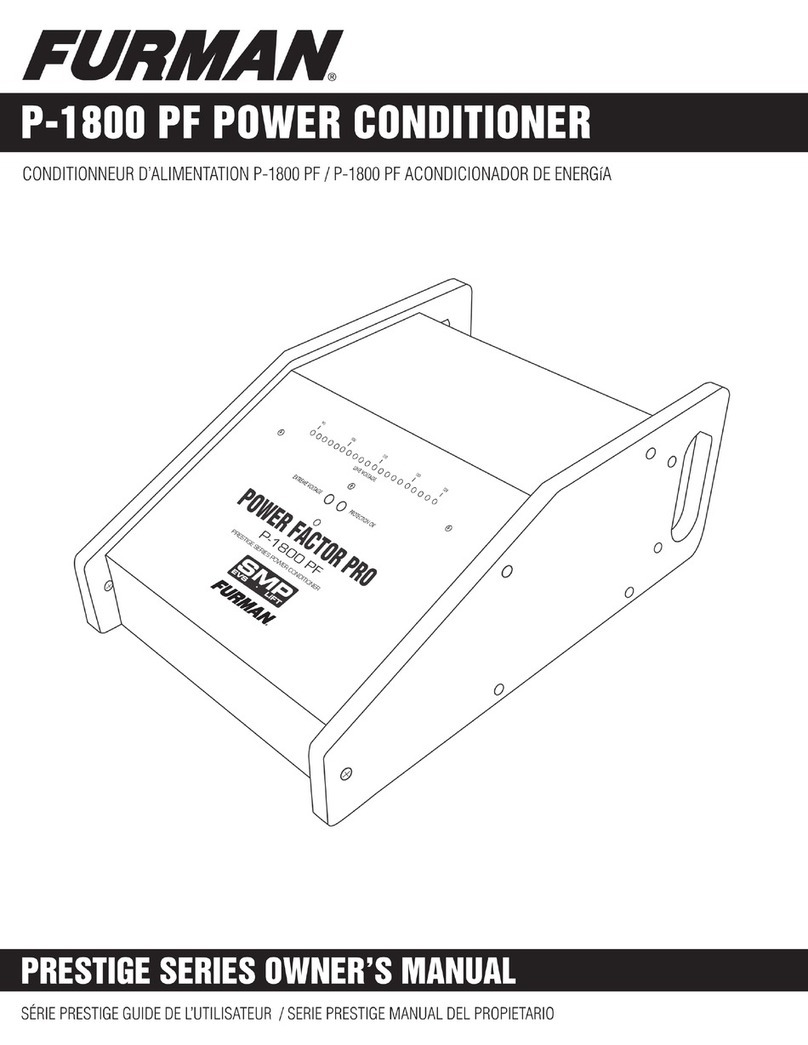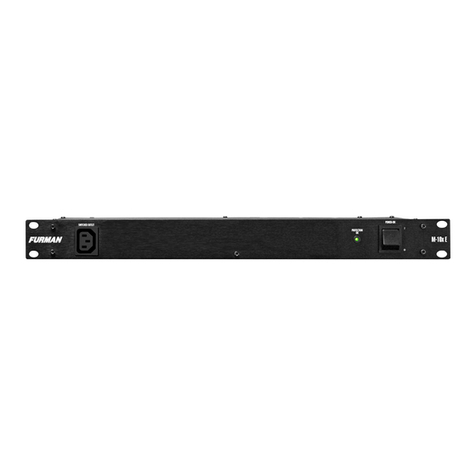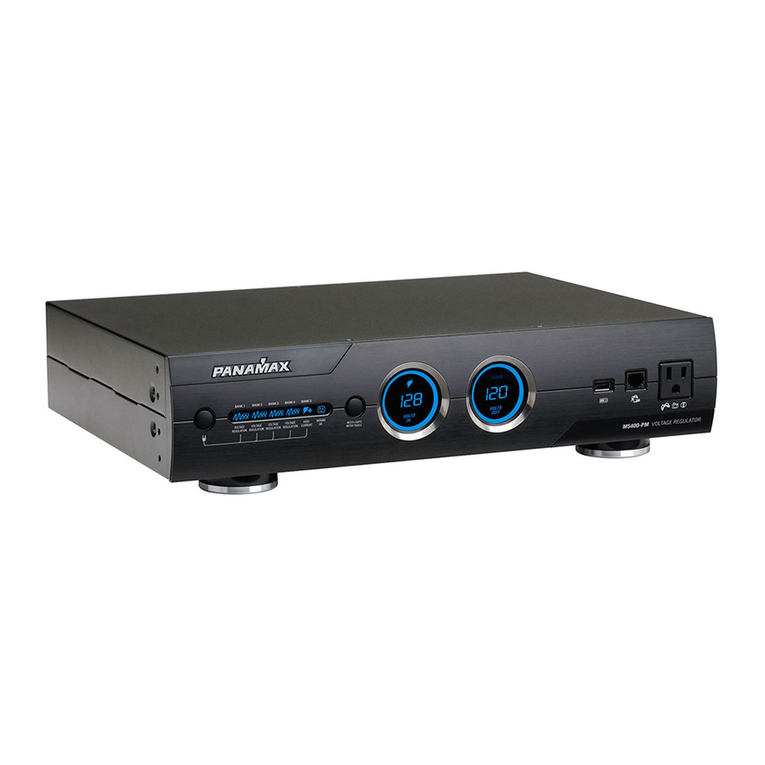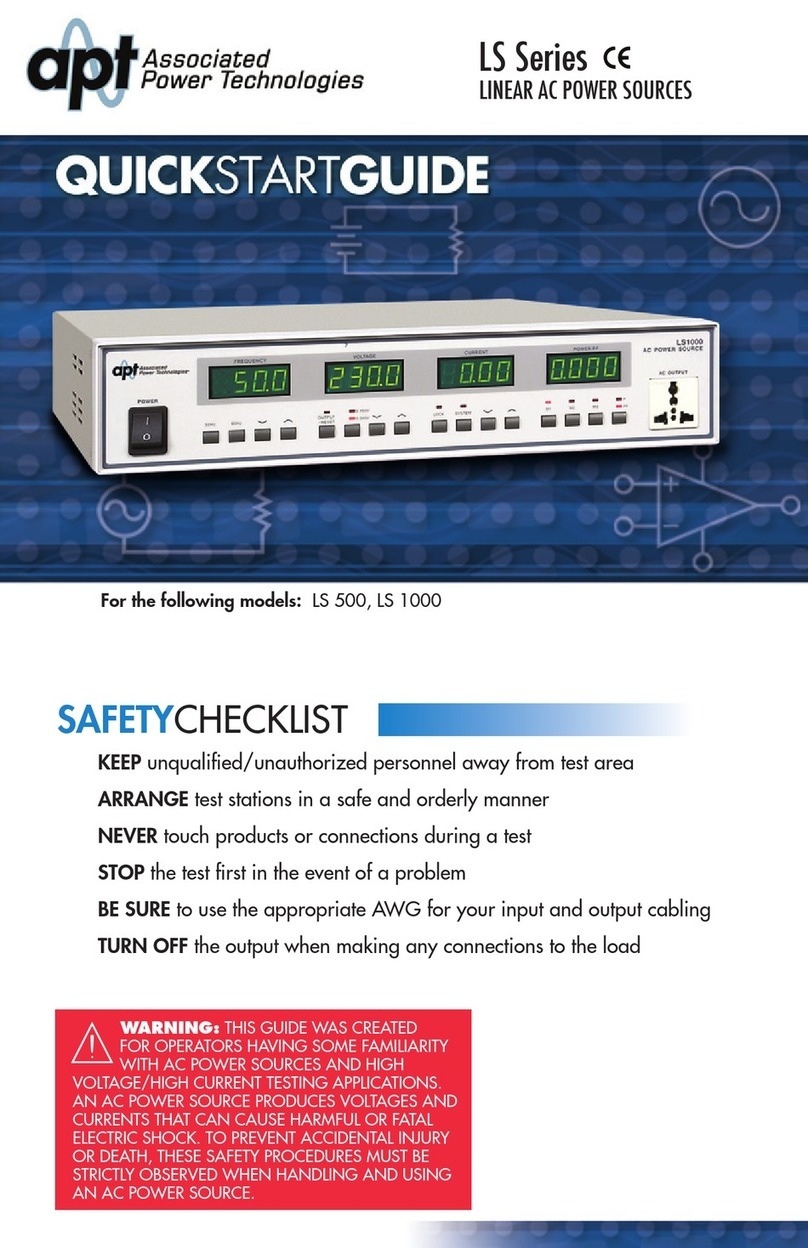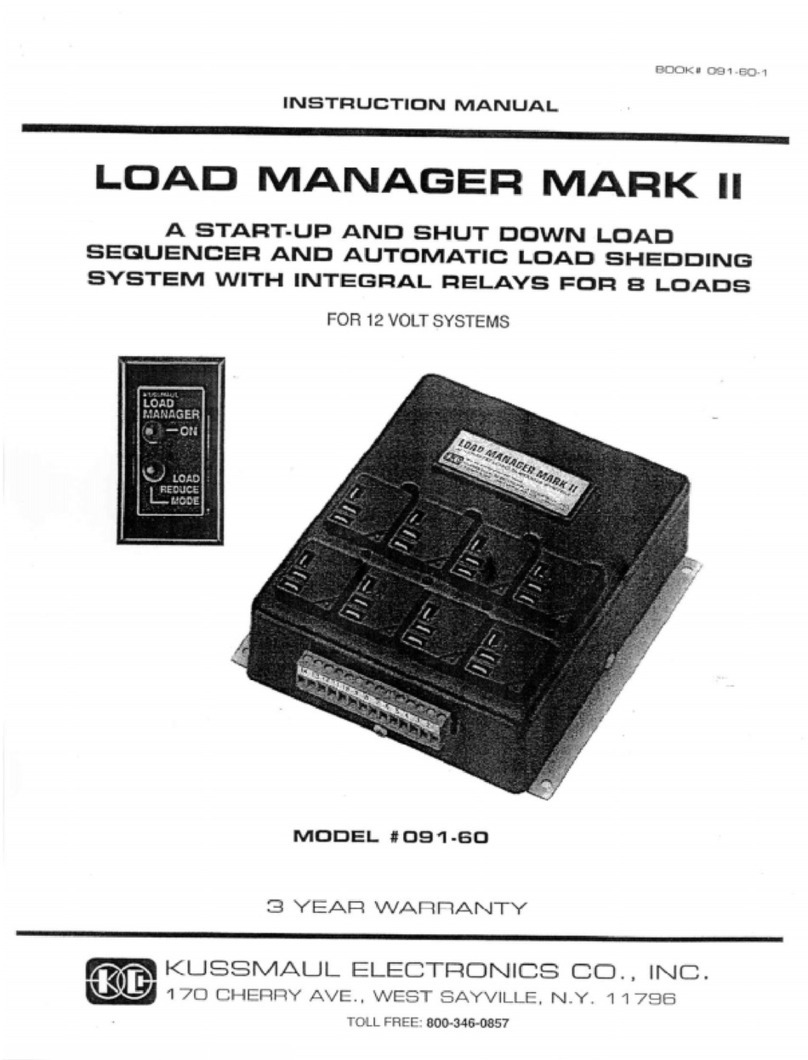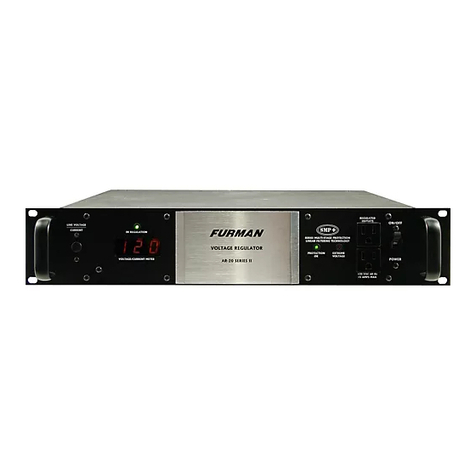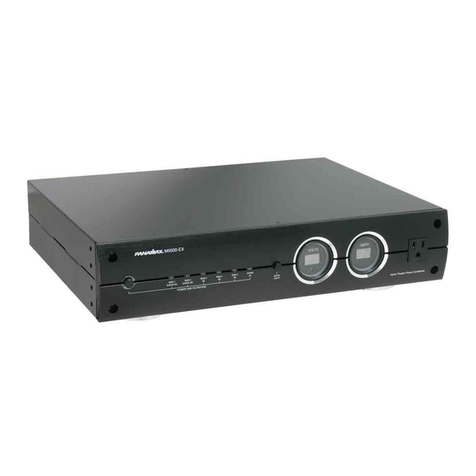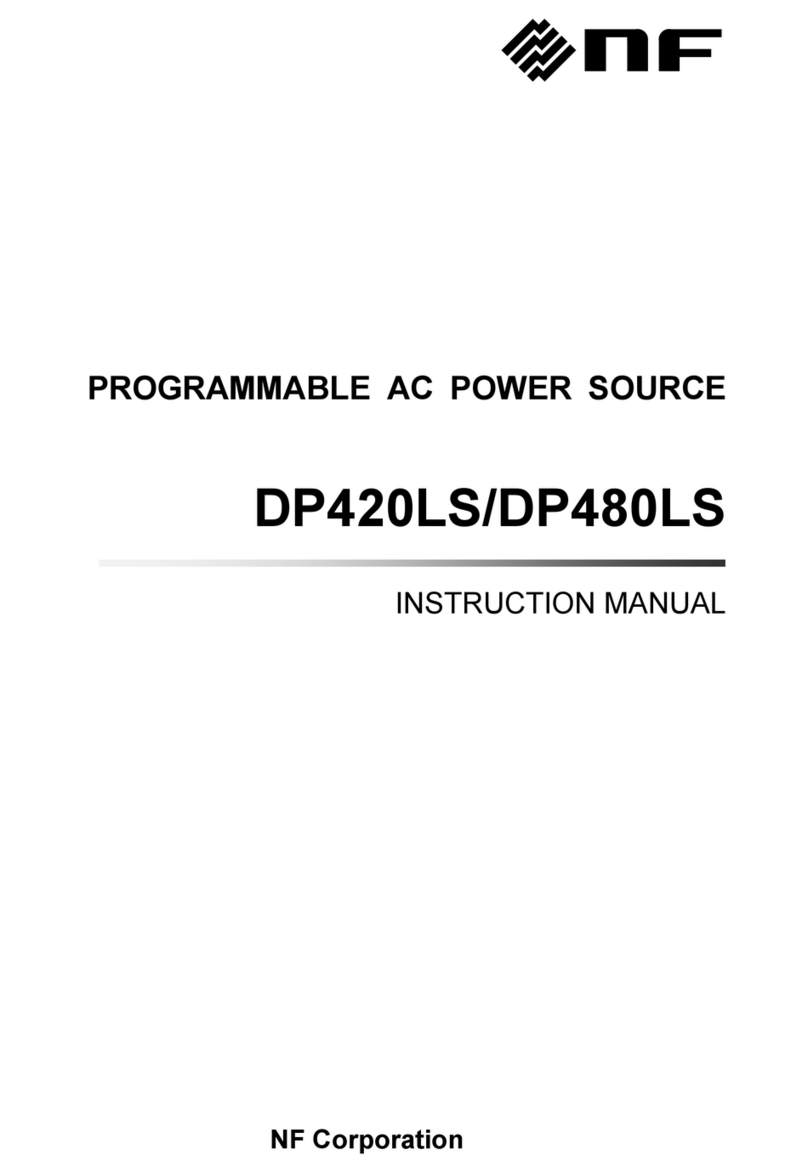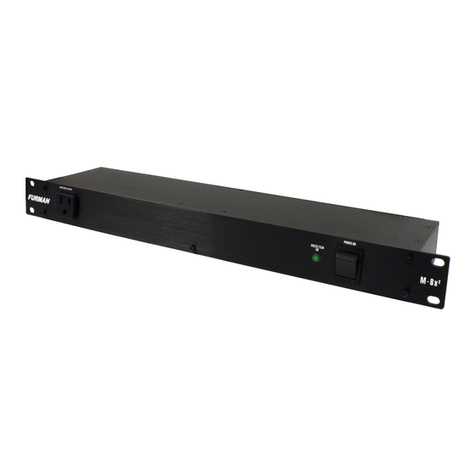B+K precision 1657 User manual

Model: 1657
AC Power Source
USER MANUAL

Safety Summary
The following safety precautions apply to both operating and maintenance personnel and must be
observed during all phases of operation, service, and repair of this instrument. Before applying power,
follow the installation instructions and become familiar with the operating instructions for this
instrument.
If this device is damaged or something is missing, contact the place of purchase immediately.
This manual contains information and warnings that must be followed to ensure safe operation as well
as maintain the meter in a safe condition.
GROUND THE INSTRUMENT
To minimize shock hazard, the instrument chassis and cabinet must be connected to an electrical
ground. This instrument is grounded through the ground conductor of the supplied, three-conductor ac
power cable. The power cable must be plugged into an approved three-conductor electrical outlet. Do
not alter the ground connection. Without the protective ground connection, all accessible conductive
parts (including control knobs) can render an electric shock. The power jack and mating plug of the
power cable meet IEC safety standards.
DO NOT OPERATE IN AN EXPLOSIVE ATMOSPHERE
Do not operate the instrument in the presence of flammable gases or fumes. Operation of any electrical
instrument in such an environment constitutes a definite safety hazard.
KEEP AWAY FROM LIVE CIRCUITS
Instrument covers must not be removed by operating personnel. Component replacement and internal
adjustments must be made by qualified maintenance personnel. Disconnect the power cord before
removing the instrument covers and replacing components. Under certain conditions, even with the
power cable removed, dangerous voltages may exist. To avoid injuries, always disconnect power and
discharge circuits before touching them.
DO NOT SERVICE OR ADJUST ALONE
Do not attempt any internal service or adjustment unless another person, capable of rendering first aid
and resuscitation, is present.
DO NOT SUBSTITUTE PARTS OR MODIFY THE INSTRUMENT
Do not install substitute parts or perform any unauthorized modifications to this instrument. Return the
instrument to B&K Precision for service and repair to ensure that safety features are maintained.
WARNINGS AND CAUTIONS
WARNING and CAUTION statements, such as the following examples, denote a hazard and appear
throughout this manual. Follow all instructions contained in these statements.
A WARNING statement calls attention to an operating procedure, practice, or condition, which, if not
followed correctly, could result in injury or death to personnel.
A CAUTION statement calls attention to an operating procedure, practice, or condition, which, if not
followed correctly, could result in damage to or destruction of part or all of the product.
WARNING:
Do not alter the ground connection. Without the protective ground connection,
all
accessible conductive parts (including control knobs) can render an electric shock. The
power jack and mating plug of the power cable meet IEC safety standards.
WARNING:
To avoid electrical shock hazard, disconnect power cord before removing covers. Refer
servicing to qualified personnel.

2
CAUTION:
Before connecting the line cord to the AC mains, check the rear panel AC line voltage
indicator
. Applying a line voltage other than the indicated voltage can destroy the AC line
fuses. For continued fire protection, replace fuses only with those of the specified voltage
and current ratings.
CAUTION:
This product uses components which can be damaged by electro-
static discharge (ESD).
To avoid damage, be sure to follow proper procedures for handling, storing and
transporting parts and subassemblies which contain ESD-sensitive components.
WARNING
HAZARDOUS VOLTAGES IN EXCESS OF 230 Vrms, 400 V peak MAY BE PRESENT WHEN
COVERS ARE REMOVED.QUALIFIED PERSONNEL MUST USE EXTREME CAUTION WHEN
SERVICING THIS EQUIPMENT. CIRCUIT BOARDS, TEST POINTS, AND OUTPUT VOLTAGES
MAY ALSO BE FLOATING ABOVE (BELOW) CHASSIS GROUND.
CAUTION:
Before applying power verify that the product is set to match with the line voltage. Ensure that the AC
power line ground is properly connected to the AC Source input connector. Similarly, other power
ground lines including those to application and maintenance equipment MUST be properly grounded for
both personnel and equipment safety.
Always ensure that AC input power is de-energized prior to connecting or disconnecting the power
cable. Similarly, the AC Source mains switch must be switched OFF prior to connecting or
disconnecting LOADS.
In normal operation, the operator does not have access to hazardous voltages within the chassis.
However, depending on the application configuration, HIGH VOLTAGES HAZARDOUS TO HUMAN
SAFETY may be normally available on the output terminals if it is connected to a load. The User must
ensure that the Source Output lines are properly labeled as to the SAFETY HAZARDS and any that
inadvertent contact with hazardous voltages is eliminated.
For authorized service technicians only: Guard against risks of electrical shock during open cover
checks by NOT TOUCHING any portion of the electrical circuits. Even when power is OFF, capacitors are
well known to retain an electrical charge. Please allow sufficient time for discharge of storage elements
before opening the cover. Use SAFETY GLASSES during open cover checks to avoid personal injury by
any sudden component failure.
Always replace the fuse with the appropriate rating only. Do not operate the instrument in the presence
of flammable gases or fumes.

TABLE OF CONTENTS
Safety Summary .....................................................................................................................................................1
C H A P T E R 1................................................................................................................................................4
1.1 INTRODUCTION ................................................................................................................................5
1.2 FEATURES ..........................................................................................................................................5
1.3 SPECIFICATIONS...............................................................................................................................5
C H A P T E R 2................................................................................................................................................7
2.1 INTRODUCTION ................................................................................................................................8
2.2 UNPACKING.......................................................................................................................................8
2.3 INPUT POWER REQUIREMENTS ....................................................................................................8
2.4 INSTALLATION..................................................................................................................................9
2.5 TEST EQUIPMENT REQUIREMENTS ...........................................................................................10
2.6 PACKAGE CONTENTS....................................................................................................................10
C H A P T E R 3..............................................................................................................................................11
3.1 FRONT PANEL DESCRIPTION.......................................................................................................12
3.2 REAR PANEL DESCRIPTION .........................................................................................................12
3.3 INITIAL CHECK ...............................................................................................................................13
3.3.1 Default Settings ..............................................................................................................................13
3.3.2 Initial Display .................................................................................................................................13
3.4 OPERATING INSTRUCTIONS IN LOCAL MODE ........................................................................14
3.4.1 Setting Voltage and Frequency.......................................................................................................14
3.4.2 Local Mode setting. ........................................................................................................................16
3.4.3 Range Selection ..............................................................................................................................16
3.4.4 Alarm..............................................................................................................................................16
C H A P T E R 4..............................................................................................................................................17
4.1 RS232C INTERFACE ........................................................................................................................18
4.2 CONNECTION DETAILS.................................................................................................................18
4.3 REMOTE PROTOCOLS....................................................................................................................19
C H A P T E R 5..............................................................................................................................................28
5.1 MAINTENANCE ...............................................................................................................................29
5.2 TROUBLESHOOT GUIDE................................................................................................................29
SERVICE INFORMATION.................................................................................................................................31
LIMITED ONE-YEAR WARRANTY ................................................................................................................31

C H A P T E R 1
General Information
1.1 INTRODUCTION
1.2 FEATURES
1.3SPECIFICATIONS

5
1.1 INTRODUCTION
The 1657 is an AC power source that provides high conversion efficiency and
low distortion output. It has a universal line output terminal and has a built in
PFC to provide an input power factor of 0.99 at full load. The output AC provides
up to 1500 VA and can be set to two voltage ranges, 135 V and 270 V. Front
panel buttons and control knob is available for quick voltage and frequency set.
A RS232 interface port is provided in the rear panel for remote programmability.
1.2 FEATURES
•Low distortion sine-wave output with programmable frequency and
voltage.
•Selectable two output voltage ranges: 135VAC or 270VAC
•Settable frequency from 45Hz to 450 Hz.
•Built-in torroidal isolation transformer.
•Automatic protection against overload, short circuit and over
temperature.
•Bright VFD display
•Remote Programming through RS 232 serial interface.
•Built in PFC provides 0.99 input power factor.
•Conforms to EN 55022, class A, safety standard EN 60950.
1.3 SPECIFICATIONS
The operation specifications are listed below. All specifications are tested at the
output terminal, with temperature at 25 °C ± 5°C, nominal input of 120V
AC/230V AC and output of 250VAC/125VAC, and at 50Hz/60Hz with a resistive
load.
Model
1657
INPUT
Voltage
90 – 264 VAC single phase
100 – 264 VAC for continuous full load operation
Frequency
47 – 63 Hz
Current
20A Max.
Power factor
0.99 typical. @115 VAC 60 Hz, Full Load
Efficiency
> 85% at full load & nominal line input
OUTPUT
Output Power
Maximum Power
1500 VA
Accuracy
+/- 2% of F.S.
Resolution
1 W
Output Voltage

6
Low Range
0 - 135 Vrms
High Range
0 - 270 Vrms
Accuracy
+/- 1% of F.S.
Resolution
0.1 V
Distortion
< 2% @ 220 VAC, 50 Hz Full Load
Worse case: < 5% @ 270VAC, 450 Hz, Full Load
Line Regulation
+/- 0.1% of F.S.
Load Regulation
+/- 1% of F.S.
Temp Coefficient
0.05% per °C from 25 °C
Output Current
Low Range (135 V)
12 Arms (Limited to 1500 VA)
High Range (270 V)
6 Arms (Limited to 1500 VA)
Accuracy
+/- 1% of F.S.
Resolution 0.01 A
Crest Factor
3
Power Factor
0.8 Lag to 0.8 Lead
Output Frequency
Range
45 – 450 Hz
Accuracy
0.2% of F.S.
Resolution
0.01 Hz
Supplemental Characteristics
Protections Output
Trip
with
Alarm
indication for
OL, SC,
OTP
Output Connection
Universal socket
Cooling Internal force cooling
Note: Provide sufficient space around air inlets
and outlets for proper cooling
Weight Approx.
Approx. 24 kg (53 lbs)
Dimensions
88.0 mm (H) x 482.6 mm (W) x 500.0 mm (D)
3.46” (H) x 19” (W) x 19.7” (D)
Safety & EMC
EN 60950 & EN55022 Class A
Environmental Conditions
Operating
Temperature
0 – 45
°
C
Storage
Temperature
-20 to +60°C
Humidity
< 90% non-condensing

7
C H A P T E R 2
Installation
2.1 INTRODUCTION
2.2 UNPACKING
2.3 INPUT POWER REQUIREMENTS
2.4 INSTALLATION
2.5 TEST EQUIPMENT REQUIREMENTS
2.6 PACKAGE CONTENTS

8
2.1 INTRODUCTION
The 1657 is configured, calibrated and tested prior to shipment. This
instrument is therefore ready for immediate use upon receipt. The initial
physical inspections should be made to ensure that no damage has been
sustained during shipment.
2.2 UNPACKING
Inspect the shipping container before accepting it from the carrier. If damage
to the container is evident, remove the instrument from the container and
visually inspect it for damage to the instrument case and parts.
If damage to the instrument is evident, a description of the damage should be
noted on the carrier's receipt and signed by the driver or carrier agent. Save all
shipping containers and material for inspection. Forward a report of any
damage to the factory or the agent through which the unit is procured.
Retain the original packing container if subsequent repackaging for return to
the factory were required. Repackaging is straightforward and is essentially
the reverse of the unpacking. Should only a sub-assembly need to be
repackaged for re-shipment, use the original containers.
Remove the Source module from its shipping container and inspect for any
damage to the front panel switches and display module. Check the rear of the
instrument for damage to Sockets, Fuse Holders and Terminals etc. Also check
for any optional parts, which have been ordered by you. If any of the part is
damaged or broken then DO NOT switch-ON the instrument.
Next, you MUST become familiar with the unit configuration.
2.3 INPUT POWER REQUIREMENTS
The Model 1657 is configured at the factory to operate from 90 to 264 VAC, 1 Ф
(phase), 47-63 Hz power line. The AC line input connector is type IEC320-C19.
CAUTION: THE AC SOURCE WILL BE DAMAGED IF IT IS OPERATED
AT AN INPUT VOLTAGE THAT IS OUTSIDE ITS CONFIGURED INPUT
RANGE.
FUSE
The AC power source uses a Type F 20 A fuse that is located in the fuse holder
at the rear panel of the unit. Please check the fuse before powering on the
instrument.

9
2.4 INSTALLATION
1. AC Input Power Connection
Connect the provided power cord into the input socket on the rear panel.
Before connecting to an electrical outlet, ensure the following:
a) The available line supply is compatible to your unit, meaning the voltage
and frequency must meet within the input specification operating range.
b) The available line supply is capable of supplying the maximum peak
current and power of the power supply.
WARNING: TO PROTECT THE OPERATORS, THE WIRE CONNECTED
TO THE GROUND TERMINAL MUST BE CONNECTED TO THE EARTH
GROUND. UNDER NO CIRCUMSTANCES SHOULD THIS AC SOURCE BE
OPERATED WITHOUT AN ADEQUATE GROUND CONNECTION.
2. Load Connections
A universal socket is provided on the rear panel for the output load
connections. Selection of Input Power and Load connection cabling should
follow good practice specific to the application. An output cable should be able
to handle the full load current and maximum voltage and power under worst-
case conditions of temperature, humidity, mechanical abuse, and effects of
long-term aging.
3. Turn-On
WARNING: BEFORE TURNING ON THE INSTRUMENT, ALL
PROTECTIVE EARTH TERMINALS, EXTENSION CORDS AND DEVICES
CONNECTED TO THE INSTRUMENT MUST BE CONNECTED TO A
PROTECTIVE EARTH GROUND. ANY INTERRUPTION OF THE
PROTECTIVE EARTH GROUNDING WILL CAUSE A POTENTIAL SHOCK
HAZARD.
a) Monitor the output voltage with a true RMS multimeter. Keep the
output ON/OFF switch to OFF position.
b) Turn the input power on through the input rocker switch. This will light
the front panel display. The display will show the model No. software
version No. , last set values of parameters, and the actual output
parameters.
c) There is a small delay between the time the last set values are
displayed until they are available on the output (Approx. 3 to 5
Seconds). After the output voltage has stabilized, set the voltage & the
frequency to the desired value & turn the output ON.
d) Load the output with a resistive load. If the output current exceeds the
maximum specified current limit, the alarm LED will turn on and output
will turn off (Overload trip) after some delay. This can be reset by
pressing the RESET button on the front panel.

10
NOTE: Allow sufficient OFF time once the output is TRIP’ed by abnormal
condition (Over temperature and/or Over load) before operating again.
e) Select the 135V range by using the front panel range button. Repeat
the above procedure, and check that all output parameters are correct.
If all the above parameters are correct, the unit is ready for operation.
2.5 TEST EQUIPMENT REQUIREMENTS
The following instruments will be required to test the complete installation of
the unit.
1) A 4.5 digit or better true RMS digital multimeter for verifying the input
and the output voltage and frequency of the unit.
2) Current meter for measurement up to at least 15 A or a standard current
transformer with the suitable burden with a four and half digit or better
digital multi-meter with true RMS measurement.
3) Power meter with suitable rating for input & output parameter testing.
4) A load to test and verify the operation on full load.
2.6 PACKAGE CONTENTS
The AC source is shipped with the following contents:
• 1657 AC Power Source
• User Manual
• AC Power Cord (type IEC320-C19)
Please locate each item from the original packaging and contact B&K Precision
immediately if something is missing.

11
C H A P T E R 3
Operating Instructions
3.1 FRONT PANEL DESCRIPTION
3.2 REAR PANEL DESCRIPTION
3.3 INITIAL CHECK
3.4 OPERATING INSTRUCTIONS IN LOCAL MODE

12
3.1 FRONT PANEL DESCRIPTION
1. Power ON/OFF switch
2. VFD display
3. Adjustment knob
4. V-SET button
5. FREQ-SET button
6. LOCAL button
7. RANGE button
8. Output ON/OFF button
9. RESET button
10. Alarm LED indicator
11. Output On/Off LED indicator
3.2 REAR PANEL DESCRIPTION
1. RS232 DB-9 serial port
2. Universal socket AC output (1500 VA Max.)
3. Earth ground terminal
4. Fuse holder (20 A type F)
5. AC Line input (type IEC320-C19)
1
2
3
4
5
1
2
3
4
5
6
7
8
9
10
11

13
3.3 INITIAL CHECK
WARNING:BEFORE TURNING ON THE INSTRUMENT, ALL PROTECTIVE EARTH
TERMINALS, EXTENSION CORDS AND DEVICES CONNECTED TO THE INSTRUMENT MUST
BE CONNECTED TO A PROTECTIVE EARTH GROUND. ANY INTERRUPTION OF THE
PROTECTIVE EARTH GROUND WILL CAUSE A POTENTIAL SHOCK HAZARD.
3.3.1 Default Settings
The default factory setting for the output parameters are as follows:
VOLTAGE
10 V
FREQUENCY
50 Hz
RANGE
270 V
OUTPUT STATUS OFF
OPERATION MODE
LOC
NOTE: Whenever range is changed between 135 V and 270 V, output
will automatically switch to OFF for safety.
3.3.2 Initial Display
Flip the power switch to turn on the power, and the front panel display will turn
on. It will first show the model number, then firmware version, then output
status, and then the actual output parameters after one second.
V A RANGE
B&K PRECISION
ACS1657
Hz W REM/LOC
V A RANGE
Vx.xxxxx
Hz W REM/LOC
After 1 second

14
There is a small delay that follows to set the output voltage to the last set value
(Approx. 3 to 5 Seconds). After the output voltage gets stabilized, users can then
set the voltage and/or frequency to their desired values.
NOTE: Allow sufficient OFF time (Minimum 2 Minutes) before turning ON
again if the output is TRIP’ed by abnormal condition (Over temperature
and Over load).
3.4 OPERATING INSTRUCTIONS IN LOCAL MODE
3.4.1 Setting Voltage and Frequency
Setting Output Voltage
To set the voltage for the output, follow the steps below:
1. Press V-SET button on the front panel to go into Voltage Set mode. The
display should look like the figure below.
V A RANGE
10.0 HI
60.0 LOC
Hz W REM/LOC
V A RANGE
0.0 0.00 LOW
60.0 0.00 LOC
Hz W REM/LOC
After 1 second

15
V A RANGE
Hz W REM/LOC
2. Use the rotary knob to adjust the digit selected by the cursor, which by
default will appear under the least significant digit of the voltage parameter
on display.
3. To change cursor position, press the rotary knob. This only works while the
unit is in Voltage Set mode and cursor is shown on the display.
4. Once you set to the voltage you want, press V-SET button again to exit
Voltage Set mode or leave the unit idle for 10 seconds and it will
automatically exit out of Voltage Set mode.
Setting Output Frequency
To set the frequency for the output, follow the steps below:
1. Press FREQ-SET button on the front panel to go into Frequency Set mode.
The display should look like the figure below.
V A RANGE
10.0 0.05 HI
50.001 LOC
Hz W REM/LOC
2. Use the rotary knob to adjust the digit selected by the cursor, which by
default will appear under the least significant digit of the voltage parameter
on display.
3. To change cursor position, press the rotary knob. This only works while the
unit is in Frequency Set mode and cursor is shown on the display.
4. Once you set to the voltage you want, press FREQ-SET button again to
exit Frequency Set mode or leave the unit idle for 10 seconds and it will
automatically exit out of Frequency Set mode.
10.00.05 HI
50.0 1 LOC

16
3.4.2 Local Mode setting.
The operation mode of the unit is clearly indicated in the VFD display above
REM/LOC, in which REM indicates remote mode and LOC indicates local mode.
If the unit received any of the set commands through the RS232 port, it will
automatically go into REM mode.When this happens, front panel keys will be
disabled except for the LOC button. To set instrument back to local mode, press
the LOC key. The display will then show LOC to indicate local mode.
Note: READ? command will not automatically set instrument into remote mode.
3.4.3 Range Selection
User can select the output voltage range by using the RANGE switch. This will
allow the user to select between 135 V range or 270 V range. The selected output
voltage range is clearly displayed on the VFD display below RANGE label as LOW
for 135V range and HI for 270V range.
CAUTION:DISCONNECT THE LOAD CONNECTED TO THE OUTPUT
TERMINALS BEFORE CHANGING THE RANGE.
3.4.4 Alarm
This is a red LED indicating OL (over load), SC (short circuit), or OT (over
temperature) status. This LED will remain on even if any of the protection status
disappears. The alarm can be reset by pressing the RESET switch on the front
panel.

C H A P T E R 4
Remote Interface
4.1 RS232C INTERFACE
4.2 CONNECTION DETAILS
4.3 REMOTE PROTOCOLS

18
4.1 RS232C INTERFACE
The 1657 AC power supply has a RS232 interface in the rear panel for remote
communication. The serial settings are shown below:
BAUD RATE
9600
DATA BITS
8 BITS
STOP BITS
1 BIT
PARITY
NO PARITY
HANDSHAKING
NO HANDSHAKING
The Data format is shown as:
ONE
START
BIT
8 DATA BITS
NO
PARITY
BIT
1
STOP
BIT
4.2 CONNECTION DETAILS
The RS232 interface is a 9 pin D-type male connector (DB-9) on the rear panel.
Users must use a Null modem or Cross over serial DB-9 cable in order to
communicate with the instrument. The instrument uses only 3 of the pins, and
their assignments are shown below:
PIN NUMBER
DESCRIPTION
PIN 2
Transmit Data (TXD)
PIN 3
Receive Data (RXD)
PIN 5
Ground (GND)
9 PIN D-Type MALE Connector.
NOTE: Since the RS232 communication does not use handshaking, the
DSR input of the controller should be tied to a signal that is always

19
logical TRUE. However this implies that your BUS CONTROLLER must
always be ready to accept the data.
4.3 REMOTE PROTOCOLS
This section describes the complete command set for remote communication via RS232
interface. It specifies the syntax of each command, and all of them will explicitly take
the unit to REM mode of operation.
TERMINATION CHARACTER
All commands, transmitted between the instrument and the computer, are terminated
with a Linefeed (LF) character (“\n” or 0x0A). Carriage Return (CR) character (“\r” or
0x0D) can also be used to terminate commands sent to the instrument, but all returned
strings from query strings will terminate with LF character.
SCPI Commands
Numerical data Formats
<NR1> Digits with an implied decimal point assumed at the right of the least-significant
digit. Example: 273
<NR2> Digits with an explicit decimal point. Example: .0273
<NR3> Digits with an explicit decimal point and an exponent. Example: 2.73E+2
<Bool> Boolean Data. Example: 0|1 or OFF|ON (0 = OFF; 1 = ON)
<Nrf> Extended format that includes <NR1>, <NR2>, and <NR3>. Examples: 273273.
2.73E2
<Nrf+> Expanded decimal format that includes <NRf> and MINMAX. Examples: 273
73.2 .73E2 MAX. MIN and MAX are the minimum and maximum limit values that are
implicit in the range specification for the parameter.
Notations
<sp>= Indicates a null or space character (0x20)
OUTPUT SUBSYSTEM
OUTP
This command enables or disables the output. Turns the output ON or OFF.
Command Syntax: OUTP[:STAT] <bool>
Parameters: 0|1|ON|OFF
Examples: OUTP<sp>OFF; OUTP<sp>1;OUTP<sp>0; OUTP<sp>ON
Query Syntax: OUTP[:STAT]?
Returned Parameters: ON|OFF
SOURCE SUBSYSTEM
[SOUR:]VOLT[:LEV][:IMM][:AMP] <Nrf>
This command programs the ac rms output voltage level of the ac source.
Table of contents
Other B+K precision AC Power Distribution manuals
